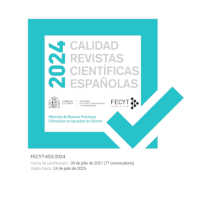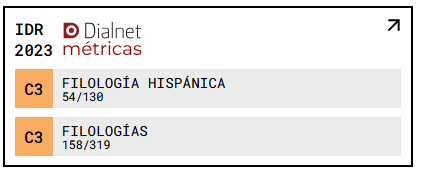Towards a verification of giraldine legacy in the dramas of Juan de la Cueva
DOI:
https://doi.org/10.18172/cif.6267Keywords:
golden theater, dramatic prescriptive, Juan de la Cueva, Giraldi CinthioAbstract
To date, critics have traditionally agreed that the greatest contribution of Sevillian playwright Juan de la Cueva to Golden Drama was his role a precursor of the so-called “new comedy” implemented by Lope de Vega. However, we should not undervalue his importance as an innovator and reformer of Spanish Theatre in the last 16th Century. This collaboration tries to highlight de la Cueva´s ability to assimilate both the theoretical postulates and the dramatic praxis that Giambattista Giraldi Cinthio (1504-1573) exemplifies in his tragedy Orbecche (1543) and put them into practice in his drama The Tyran Prince (1583). Through a contrastive analysis of both dramas, we show that Cueva not only knew Cinthio’s reformist theses, bat also transferred the innovations of the Geraldine legacy to his plays in order to make them accessible to an uncultivated spectator.
Downloads
References
ARELLANO, I. (2005), Historia del Teatro Español del siglo XVI y XVII, Madrid, Cátedra.
BURGILLO, F. J. (2010). Juan de la Cueva en el nacimiento del drama histórico, Salamanca, Universidad de Salamanca.
CUEVA, Juan de la, (1588), “Epístola Dedicatoria a Momo”, en Primera Parte de las Comedias y Tragedias de Juan de la Cueva, Sevilla, Imprenta de Juan León.
CUEVA, Juan de la, (1588), Tragedia del Príncipe Tirano, en Primera Parte de las Comedias y Tragedias de Juan de la Cueva, Sevilla, Imprenta de Juan León.
CUEVA, Juan de la, (1995), Exemplar poético, edición digital a partir de la de Espasa-Calpe, Madrid, http://www.cervantesvirtual.com/obra-visor/ejemplar-poetico--0/html
CASTORINA, C. (2017), “Orbecche.Giovan Battista Giraldi Cibthio. Censimento: tragedia, cinque-scicienteche”, en Studi Giraldini, Letteratura e Teatro, III: 235-262.
FROLDI, R. (1999), “Reconsiderando el teatro de Juan de la Cueva”, en El teatro en tiempos de Felipe II, Actas de XXI Jornadas de Teatro Clásico de Almagro, Almagro, Universidad de Castilla-La Mancha: 15-30.
GRANJA, A (1997) “Lope de Vega, Jerónimo Velázquez y la fiesta del Corpus (1584-1588), en Edad de Oro, 16: 189-206.
GIRALDI CINTHIO, G. (2014), Orbecche, en casa de figloiuli d´Alda, Venecia, 1553. Edición digital por Pau Sanchís, Bibloteca Virtual Emothe, Valencia, https://emothe.uv.es/biblioteca/textosEMOTHE/EMOTHE0214_Orbecche.php
GIRALDI CINTHIO, G (20119, Discursi intorno al comporre delle comedie, et delle tragedia, Ferrara, In vinegia Apresso Gabriel Giolito et fratelli, 1553. Seguimos la versión inglesa de Daniel Jatvich, en Renaissance drama, 39: 207-255. DOI: https://doi.org/10.1353/rnd.2011.0001
GIRALDI CINTHIO, G. (2002), Discursi intorno al comporre. Revisti dall´autore nell esemplare ferrarese, Susanna Villari (ed.), Messina, Centro Interdepartamentale di Studi Umanici.
HERMENEGIDO, A. (2003) “La tragedia: de Pérez de Oliva a Juan de la Cueva”, en Historia del Teatro Español, Javier Huerta Calvo, (ed.), Madrid, Gredos, Vol. I: 475-499.
LÓPEZ PINCIANO, A. (1894), Filosophia antigua poética, Imprenta y Librería Nacional y Extranjera de Hijos de Rodríguez.
MATA CABALLERO, J. (2011), “El poder de la tragedia: El Príncipe tirano, de Juan de la Cueva”, en XXIV y XXV Jornadas de Teatro del Siglo de Oro, Almería, Instituto de Estudios Almerienses: 77-109.
MÉNDEZ OLIVER, A, (2007), “Obrecche y los tratados neo-clásicos de Giovan Battista Giraldi Cinthio”, en Ficciones Lagales, Carmen Rabell (ed.), Santiago de Chile, Maitem III: 63-78.
PASTOR COMÍN, J. J. (1999), “El Ejemplar poético, de Juan de la Cueva: teoría dramática de un sevillano que pasó sus últimos años en la ciudad de Cuenca”, en Archivo Conquense, II: 177-209.
RABELL, C. (2003), Rewritting the Italian novells in Counter-Reformation Spain, Londres, Tamesis Books. DOI: https://doi.org/10.1017/9781846151446
REYES PEÑA, M. et al., (2008), El Príncipe Tirano, Comedia y Tragedia de Juan de la Cueva, Sevilla, Centro de Documentación de las Artes Escénicas de Andalucía.
ROJAS VILLANDRANDO, A. (1603), “Loa de la comedia”, en El viaje entretenido, Madrid, Imprenta Real.
ROMERA PINTOR, I. (2017) “El «docto» Cinthio en Esapaña”, en Teatro Hispánico y su puesta en escena, José Luis Canet, (ed.), Valencia, Publicaciones de la Universidad de Valencia.
RUIZ RAMÓN, F. (1983), “Prólogo” a G. Lasso de la Vega, Tragedia de la destruyicion de Constantinopla. Andrés Hermenegildo (ed.). Kassel, Ediciones Reichemberger.
SÁNCHEZ ARJONA, J. (1887), “El maestro Juan de Mal Lara”, en El teatro en Sevilla en los siglos XVI y XVII, Madrid, Establecimiento de A. Alonso.
VILLARI, S. (2915), “Dallo scrittoio al teatro: Considerazioni sule tragedia giraldine, en Italique, XVIII: 13-34. DOI: https://doi.org/10.4000/italique.401
Downloads
Published
How to Cite
Issue
Section
License
Copyright (c) 2024 Víctor Cantero García

This work is licensed under a Creative Commons Attribution 4.0 International License.
The authors retain copyright of articles and authorize CIF the first publication. They are free to share and redistribute the article without obtaining permission from the publisher as long as they give appropriate credit to the editor and the journal.
Self-archiving is allowed too. In fact, it is recommendable to deposit a PDF version of the paper in academic and/or institutional repositories.
It is recommended to include the DOI number.
This journal is licensed under a Creative Commons Attribution 4.0 International License














